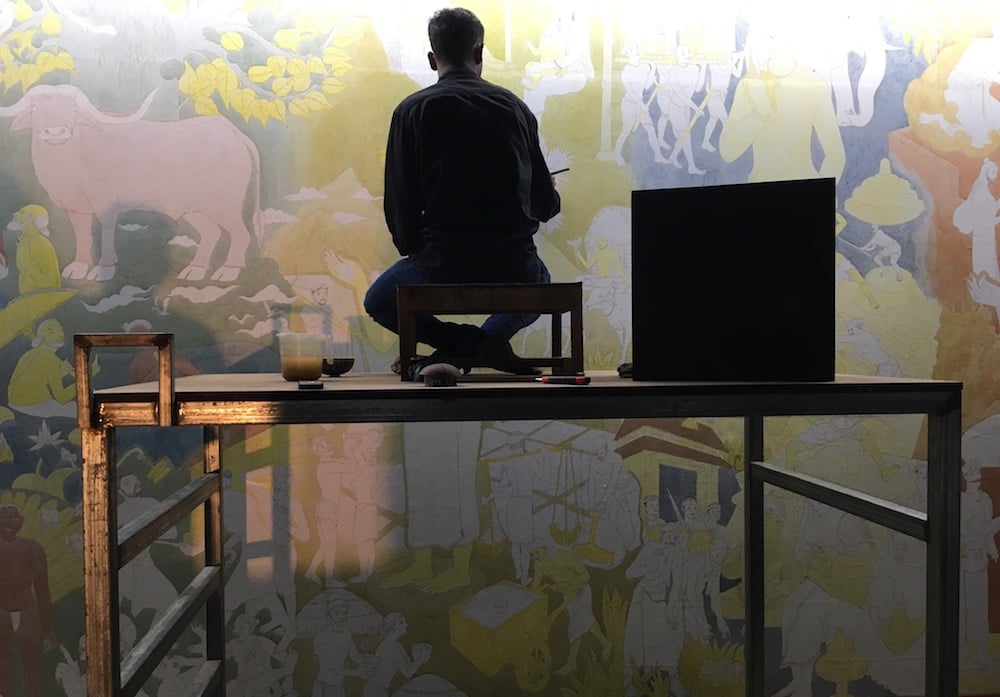
At a first-look preview of the 2016 Kochi-Muziris Biennale (KMB) yesterday evening, curator Sudarshan Shetty guided a small group through what is still a work-in-progress. Such is the spirit of things here, as is one of its curatorial concepts, whereby the biennale “embraces the city into the work.”
It is thus subject to its limitations too, namely delays caused by Indian customs regulations and a labor union strike protesting lack of wages due to recent demonetization policy. Nevertheless, it remains true to its founding principle: “a biennale for the people by the people.”
A rickshaw equipped with the work of artist Voldemars Johansons at the Kochi-Muziris Biennale. Photo Skye Arundhati Thomas.
A set of 100 rickshaws roam the old Fort Kochi streets, equipped with work by Latvian artist Voldemars Johansons. An unassuming white horn replaces the rickshaw’s own, complete with over 150 sounds of a variety of birds.
The rickshaws, with gleeful delivery by their operators, squawk their way around town, announcing that the most exciting time of the year has begun.
A detail of the work by Dia Mehta Bhupal. Photo Skye Arundhati Thomas.
As is customary with the KMB, each edition is curated by an artist with a practice attuned to the dialogues required by the process of curation. Shetty has certainly thought about this carefully, stringing together multiple narratives that snake across the city, oftentimes making connections that are not obvious straightway.
A striking example of this lies in the handling of the work by artist Dia Mehta Bhupal, whose practice involves the making of large, life-size set pieces, painstakingly crafted with long rolls of old magazine pages, weaved together in intricate patterns. Typically, Bhupal will create one set for a single photograph, after which it is packed away carefully into crates. Not this time however, as Shetty has installed a set at the main venue, Aspinwall House, as well as its photographic counterpart halfway across the city at an altogether different venue. Between the two, an entire microcosm of other work, and of course, the city itself.
A detail of the work by Dia Mehta Bhupal. Photo Skye Arundhati Thomas.
Chilean poet Raúl Zurita, who in fact was the first artist to be selected for the biennale, has created an immersive installation, in which stunning warehouse architecture meets poetry and sound. Visitors are encouraged to take off their shoes and slip into a shallow pool of sea water to walk across and read the writing on the walls. “Don’t you feel me?,” the poem asks, in reference to Aylan Kurdi, the three-year-old Syrian boy whose posthumous photograph circled the world. The sea of pain is thus a work about the refugee crisis, lightly soundtracked by the rustling water beneath visitors’ feet.
A visitor walks through the Raúl Zurita installation The sea of pain at Aspinwall House, Fort Kochi. Photo Skye Arundhati Thomas.
Zurita is not the only poet showing work at the biennale. A poem by Indian artist Sharmista Mohanty, titled I make new the song born of old, was written specifically for the architecture of Aspinwall House, where it is accompanied by sound. “You read Mohanty’s work to anchor yourself,” reads the caption for the work, “think about how you sink into the room and breathe in the atmosphere, the words become space.”
A compelling proposition, and one that presents itself in various ways throughout the show, not only with Mohanty’s work. It is clear to see that, at the current edition of KMB, commonplace notions are constantly in flux as abstractions that are to be further discussed and reexamined.
One of the four portrait rooms by Miller Puckette, part of the work Four Sound Portraits by the artist. Photo Skye Arundhati Thomas.
In a similar vein, mathematician and sound artist Miller Puckette, creator of the widely used Max/Msp and Pure Data systems, has created Four Sound Portraits, featuring the composers he most admires: John Cage, Xenakis, Charles Dodge, and Philippe Manoury. With sound pieces installed in four separate rooms, Puckette has attempted to “paint” the portraits of these men, an interesting test of the limits of portraiture, as well as an investigation into influence, namely the one that has passed between these composers and different generations. Puckette will also perform alongside the installations, the first live performance to take place this week.
A first for KMB, Shetty has put together a program of presentations and performances, ranging from poetry, sound, theater, and dance, which will take place across the biennale’s venues.
The materials of a painter’s palette. Photo Skye Arundhati Thomas.
The first look was also an intimate one, with visitors being privy to rehearsals of some upcoming performances as well as to the raw materials of painters’ palettes. The tour, led by the soft-spoken Shetty, felt confidential somehow—a crafting of suspense.
Visitors last night thronged the narrow lanes of Fort Kochi in anticipation of the grand opening this afternoon, a ceremony that will be inaugurated by the beat of 150 traditional drums. What is nevertheless immediate, and hard to ignore, is that the KMB 2016 is an extraordinary spectacle of cultural confluence, with a sophisticated and intellectual program that renders it a biennale to be reckoned with.